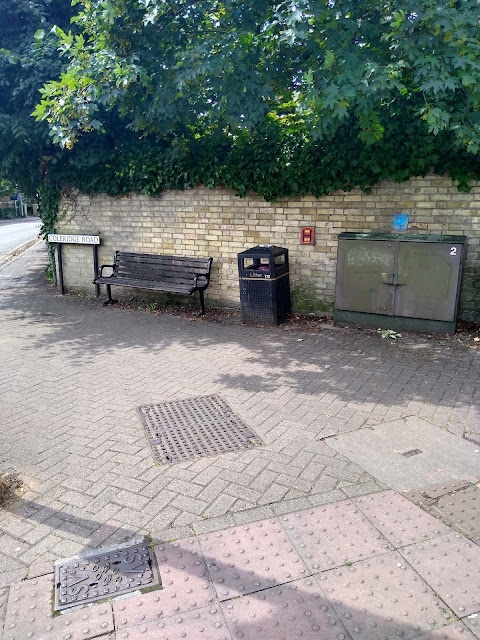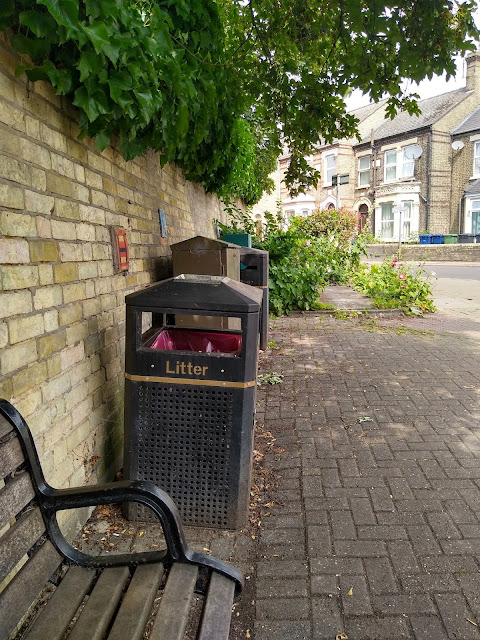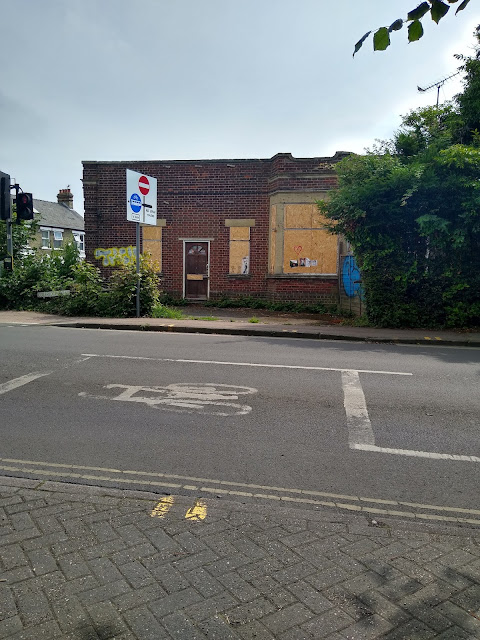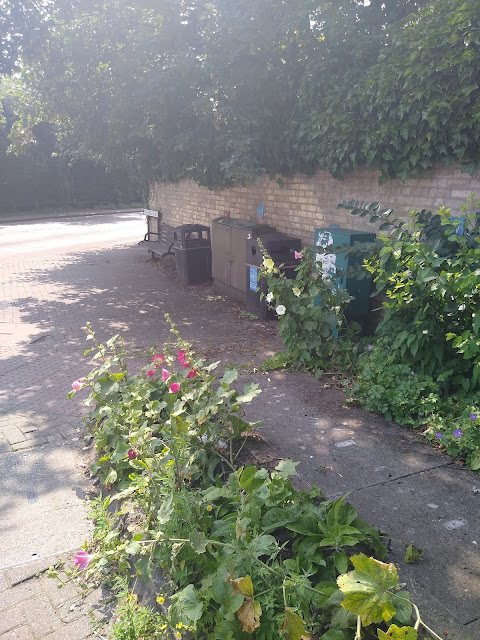The almost total removal of Covid restrictions, for the time being at least, had been heralded by ‘Freedom Day’. I cautiously felt that the grip of the pandemic was finally loosening. At least for the time being. The beginning of the end and the beginning of whatever the ‘new normal’ would look like.
I decided it was time to take stock. I had been walking the street most days, but really in a getting from A to B way, not properly noticing. Rather than just walk, I decided to include a static form of observance on one of Mill Road’s benches. There are a handful dotted along the road and I had a vague plan that having a ‘sit’ for a period on each of these. Maybe using them all over a period of time would allow me to properly immerse myself. A sort of immobile psychogeography. There were several options. There are benches around the Romsey R, one on top of Mill Road Bridge and some outside the Co-op. There are probably others I’ve never noticed. I elected though, to go to the bench on the corner of Coleridge Road.
The bench sits at a four way Junction with traffic lights with Hemingford Road opposite Coleridge Road, and Mill Road passing through the middle. It is somewhere most people probably walk by without paying too much attention. I couldn’t remember ever stopping and sitting here, or lingering in the vicinity. But when I arrived soon found myself in a place that seemed to exist in an almost separate enclave. The bench backs onto a wall, next to a couple of bins and green telecoms boxes. On the wall are two utilities markers. There are several manhole covers on the ground, including a series of concrete grey ones surrounded by tall flowering hollyhocks.
Upon sitting on the bench among these utilitarian objects and (possibly) random selection of plant life, I soon felt like I was in a sort of liminal spectator zone, where I could exist as unnoticed as the telecoms boxes.
Across Coleridge Road was the yet-to-be developed old Romsey Labour Club building. It still exists in its own liminal space surrounded by an area of decaying concrete floor and wild edgelandic vegetation. The windows are now boarded and graffiti is starting to emerged on the crumbling brown walls. But other than that, it remains in a similar state to the last time I mentioned it, in a previous blog from the beginning of the bridge closure just over a year ago. I don’t know what is preventing the development into serviced apartments, which was approved over two years ago now. I suspect the task will be easier for the developer once the building has collapsed of its own volition, particularly the facade which is meant to be retained. But for now at least, I could savour the building, which despite its sorry state, is still one of Mill Road’s best features.
The Labour Club was once the epicentre of Red Romsey or Little Russia and no doubt built to last. But its demise is symbolic of those terms being irrelevant in contemporary Romsey, as the forces of change and gentrification march ever onwards. The building is an outcrop of an otherwise buried layer of Mill Road’s history. As I observed from the bench, a black and white spray-painted Joe Strummer looked on enigmatically from the corner of one of the boarded up windows, while the Coleridge Road sign was being slowly engulfed by vegetation. The only new feature I noticed, other than the street art, is a road sign. This shows the traffic restriction due to the bridge closure to the right. Meanwhile any would-be bridge crossing cars are diverted to the left, down the stretch of Mill Road that seemed least affected by the changes brought about by Covid and the bridge closure. I reflected that the Mill Road Winter Fair, which in pre-Covid times saw the road closed for the day in December, also usually ends at this junction, leaving the leftward stretch as the only part of the road open to traffic. I wondered if the fair would be extended on its pre-Covid return to include the small number of businesses along this usually forgotten part of the street, along with a chance to visit the impressive mosque which I’m not sure was open in time for the last Mill Road fair.
My attention
wandered from the Labour Club, across the road to the Romsey Mill. At
the same time, I began to settle into the micro-environment afforded
by the bench. I became dimly aware of the background sounds of car
engines, as they waited at the lights next to where I sat before
slowly moving off. This sound became repetitive, almost unnoticed and
strangely soothing. It became a sort of aid to noticing. Outside
Romsey Mill was a tall conical tree, part obscuring the building, and
behind it another bench. I had never noticed either of these objects
before and wondered how on earth that was possible. The Romsey Mill
serves as the local polling station and to vote is the only time I’ve
ever set foot in it. It is the home of a Christian based charity that
started in 1980, in the building that was formerly a Methodist
chapel. I noticed two blocked up apertures next to the main door; a
small bricked up arched window and just below that, too low for any
sort of normal window to have existed, was a brown oblong, a 1970s
sideboard had been inserted to occupy the space and fitted perfectly.
I shifted to observing the people passing by. There was a random and rich diversity among those that I noticed. An enigmatic, sage-like ageing man with what looked like a kit-bag drifted by, possibly on a Saturday morning derive of his own. Maybe just going to the shops. A singing man with dreadlocks went by on a bike, I heard him before I saw him. He looked oblivious and carefree, in comparison to a group of hipster-types who’s man-bun attempts to a similar direction were clearly carefully and self-consciously curated. They were outnumbered by the number of old ladies I saw, heading towards the broadway utilising a range of mobility aids from the walking sticks to the full on electric mobility scooters. These were the pioneers in the new age of electric transport. I only witnessed one Voi scooter, but several white vans. As I became even more settled in my bench enclave and reached a point of imagined invisibility, the background engine sounds aided an almost meditative state.
After a while I became aware of a distant chanting, coming from the direction of the bridge. This slowly roused me and I remembered that there was a protest due to take place, organised by the traders and others from the pro-bridge reopening faction. As mentioned previously the bridge closure had caused controversy and division. The County Council were due to vote the following week to decide whether to keep the bridge closed or reopen it, while a period of consultation took place. The bridge had initially been closed with no consultation, one followed some time later but was disregarded, due to concerns that the councils consultation system allowed the same people to comment more than once. The traders saw this protest as a last stand. As their voices grew louder, I was roused from my immersive state and curious to know what was going on up the road. I realised I had only been on the bench for around twenty minutes but it felt like a lot longer. I wrenched myself into a standing position, then removed myself from its immersive atmosphere, as I passed beyond the hollyhocks and manhole covers. I looked back to the bench and its surroundings, a segment of space that was almost tangibly separate and off-kilter from its immediate surrounds, I felt like it was a protected and protective space.
The protest was in full swing as I passed it crossing the bridge. There were chants, with the aid of megaphones of ‘one Mill Road, one community’. Meanwhile, the Romsey City Councillor, Dave Baigent, a vocal pro-closure proponent, stood among the protestors in silence. The scene was a microcosm of the division the bridge closure had created and the chanting seemed almost anacronistic.
Further down the road was a delegation of people from the pro-closure faction, specifically from a group called ‘Mill Road 4 People’. This group had sprung up relatively recently with a professional looking website showing quite detailed ideas for how the bridge could stay closed and asking for views to help make this work. There has been much speculation as to who might be behind the group, with the finger being firmly pointed by several social media commentators at Cam Cycle, a vocal pro-bridge closure lobbying group. While the rhetoric and ideas of both groups seem very similar, I don’t know whether this is true. As I passed through the delegation, one of them stopped me and handed me a leaflet. I expressed my reservations around keeping the bridge closed. I asked what about the traders claims that they were seeing a fall in takings. This was brushed off, and it was pointed out that several new business had opened during the closure and these would attract more to open as footfall increased. I wondered though, who were these new businesses for and whose feet would be falling? The emphasis was largely on the more artisan end of the food market, even beyond this to include something called a ‘Fish Butchery’, which struck me as something beyond pretentious.
My earlier fears, which had dissipated earlier in the protective environment of the bench, returned. The street was in danger of becoming something beyond the parody of Nathan Barley, with its various forms of e-scooter transport gliding along the road, a proliferation of serious faced joggers and high end eateries with outside seating becoming ever more prevalent, making ambulatory activity that bit more awkward. I wondered if the solution to Cambridge’s pollution and traffic problems had to be the imposition of a ‘continental cafe culture’ and the creation of a destination resembling Hoxton aspiring to be Hampstead in Mill Road, which is what many on the pro-closure side seemed to be pushing for. Certainly, the Covid-era seems to have accelerated a move towards such an environment. It was probably on the cards anyway, but the shift has been stark in its rapidity. I felt like I had been suffering from ‘Future Shock’ over the last few month as a result. As I moved along the street, it didn’t help when I noticed Fagitos was still ‘closed for refurbishment’. I wondered if it would ever really re-open and of so in what form. The legendary late night kebab joint has been unrivalled since the 1990s and is one of Mill Road’s most iconic institutions, but has been closed for months. This seemed an ominous portent that the direction of travel was set for good. There would be no return to the comfy, slightly grubby Mill Road of ‘the before time’.
As I retracted my steps, I passed by the protestors banner still standing at the foot of the bridge. ‘Open The Bridge. Consult!’ its shouted. In my deflated state, the banner seemed to express the futility of any attempt to prevent the worst extremities of gentrification imposing a more sterile and expensive version of Mill Road. But at least the bench was there, unaffected, at least for now.
Footnote: The week after the walk/bench sit, the County Council voted to re-open the bridge while a period of consultation takes place. I can’t say I’ve noticed the traffic get much busier as a result but I suppose it is the school holidays. I’ll find another bench to try out during this next stage of flux, until the next stage of the bridge saga.




